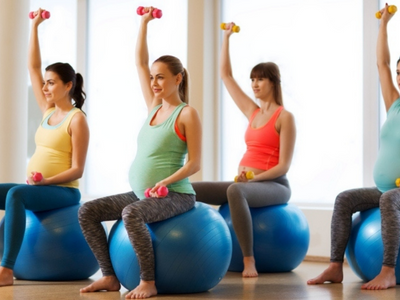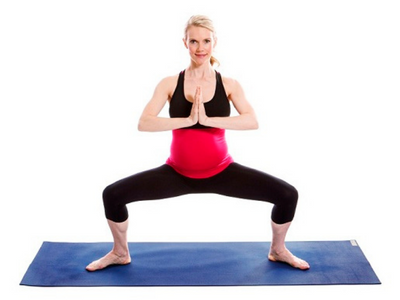For long now, women have been scared away from exercising during pregnancy, but there are more and more articles floating on the web talking about all the positive effects of exercising during a normal pregnancy. At Physiocure, we advise all women with a normal pregnancy to adopt some form of safe prenatal exercises to have an even better and injury-free time, once their baby arrives.
Current studies indicate that healthy women with an uncomplicated pregnancy do not need to limit their exercise for fear of adverse effects (Whaley et al. 2006). Women should be encouraged to do consistent, moderate-intensity exercise, however women with complicated pregnancies have been discouraged from participating in exercise activities for the fear of impacting the underlying disorder (Davies et al. 2003). According to Kramer & McDonald (2009) regular aerobic exercise during pregnancy appears to improve physical fitness. Women who are exercising prior to the pregnancy can continue to do so without any major modifications. However, many women will change their program because they have symptoms, discomfort and risks associated with joint laxity and body mass gain (Whaley et al. 2006). This joint laxity should also be taken in consideration during stretching. Most woman start exercise programs in the second trimester because often the symptoms as nausea, vomiting and profound fatigue are less in that stage.
Exercise prescription
During pregnancy maximal exercise testing is not recommended. If a test is needed this should be undertaken under the supervision of a physiotherapist. Women who were less active or sedentary before the pregnancy should go to a physiotherapist before they start exercising.The recommended mode, frequency, duration and overload of the exercise are consistent with general principles of fitness training (Table 1).
| Table 1: GENERAL FITNESS EXERCISE PROGRAM (Whaley 2006) | ||||
| Components | Frequency | Intensity | Duration | Activity |
| Cardio respiratory | 3-5 /week | 40% – 85% HRR or Vo2R 55% – 90% HRmax 12-16 RPE | 20-60 min | Large muscle groups
Dynamic activity |
| Resistance | 2-3 /week | Volitional fatigue (MMF) (e.g. 19-20 RPE)
OR Stop 2-3 reps before volitional fatigue (e.g. 16 RPE) |
1 set of 3-20 repetitions (e.g. 3-5, 8-10, 12-15) | 8-10 exercises IncRemove featured imagelude all major muscle groups |
| Flexibility | Minimal
2-3/ week Ideally 5-7/week |
Stretch to tightness at the end of the range of motion but not to pain | 15-30 seconds 2-4 repititions | Static stretch all major muscle groups |
Research also reports that light resistance training can be performed over the 2nd and 3rd semester and that does not have an effect on the newborn body size or overall health. They conclude that resistance training during pregnancy decreases the negative effects of maternal weight on the newborn size. Davies et al. (2003) recommends the `talk test´ method to monitor exertion, which means that the woman must be able to maintain a conversation during exercise. He explains that if she is unable to do so, reduced exercise is advised.
| Table 2: MODIFIED HEART RATE TARGET ZONES FOR AEROBIC EXERCISE IN PREGNANCY (Davies 2003) | ||
| Maternal Age ( in years) | Heart Rate Target Zone
(beats/min) |
Heart Rate Target Zone
(beats/10 sec) |
| Less than 20 | 140 – 155 | 23 – 26 |
| 20-29 | 135 – 150 | 22 – 25 |
| 30-39 | 130 – 145 | 21 – 24 |
| 40 or greater | 125 – 140 | 20 – 23 |
According to ACOG (2002) a prescription of 30 to 40 minutes or more of moderate activity on most or all of the days in the week is advised and 3-5 times a week for more intense physical activities. There is a difference between women who have been inactive prior to pregnancy and women who have been active. The inactive women should begin with a light-intensity program (20%-39% HRR), this means low impact activities such as walking and swimming. Previously sedentary woman should start with 15 minutes exercise, 3 times a week, increasing this gradually to 30 minutes session, four times a week. He recommends that in this session abdominal strengthening should be excluded as there may be development of diastasis recti and associated muscle weakness. However core stability is an important part of exercise during the pregnancy. Goals should include maintenance of cardiorespiratory fitness, muscle mass and physician-recommended weight gain (McArdle et al. 2006).
Pregnancy and pelvic pain have an important impact on women on a daily basis. Stuge et al. (2002) explains that lumbo-pelvic stabilization could be achieved by exercises and have an influence on appropriate posture and enhanced muscle function or by use of an orthotic device like a pelvic band could have an influence on it. He explains that there is no strong evidence that the effect of physical therapy interventions helps with the prevention of low-back pain and pelvic pain related to pregnancy but there are no facts that exercise doesn’t help. However, he mentions that water gymnastics has shown a lower pain intensity and sick leave compared to no intervention, but this could be due to the effect of attention. A training program for the pelvic floor muscle can be associated with fewer cases of active pushing in the second stage of labour lasting longer than 60 minutes.
Exercise in the Postpartum Period
Depending on the type of delivery, most types of exercises can be continued. The women may need to reduce the activities due to fatigue of delivery and newborn care. Brukhner & Khan (2007) state that the changes caused by pregnancy take some time to return to normal, so care should be taken in the first six weeks after delivery to avoid sudden high impact or contact activity. They explain that if the delivery was a caesarean section, women may need to avoid strenuous activity for six weeks and heavy weight training for 12 weeks. This depends on the recovery such as anemia or wound infection. Pelvic floor exercises are good to reduce the risk of future urinary incontinence (Morkved & Bo 2000).
Breastfeeding is a part that also needs to be considered after pregnancy. The exercises should not interfere with the ability to breastfeed. Although exercise doesn’t affect the milk production or composition, lactic acid has been shown to be increased in the breast milk of women exercising at maximal intensity, but not in those who exercising at normal level (Davies et al). 2003) the growth of breastfeeding babies of mothers who exercise is normal. This is even the case for mothers who are losing weight as part of their exercise.
Exercise to prevent complications
1. Gestational diabetes mellitus (GDM)
Avery (1997) concluded that in women who started a home-based exercise program there was no reduction in glucose levels. According to Dempsey et al. (2004) an increase in physical activity may reduce the risk of gestational diabetes mellitus. Physical activity, especially vigorous activity before pregnancy and at least light to- moderate activity during pregnancy may reduce risk for abnormal glucose tolerance and GDM (Oken et al. 2006). There is inconsistence evidence whether exercise has a positive or negative effect on gestational diabetes.
2. Preeclampsia
Preeclampsia is identified by increased blood pressure and protein in the urine, women usually don’t have any symptoms in the beginning.
Women who are doing leisure-time exercise during pregnancy where less likely to develop preeclampsia compared to those who didn’t participate in exercise. Relative to inactive women, the pregnant women who were vigorously active during pregnancy experienced a 54% reduction of risk for preeclampsia, and those who engaged in light or moderate activities experienced a 24% reduction of risk (Lewis et al. 2008).
3. Weight gain
Total weight gain is measured in the following categories: low (<10 kg), medium (10–15 kg), high (16–19 kg), or very high (>20 kg). Research explains that generally low gestational weight gain was an advantage for the mother, but it increases the risk of having a small baby, particularly for underweight women. In conclusion heavier women may benefit from avoiding high and very high pregnancy weight gain, which brings only a slight increase in the risk of growth restriction for the infant. High weight gain in underweight women does not appear to have deleterious consequences for them or their infants, but they may want to avoid low gestational weight gain to prevent having a small baby.
4. Labor and Birth
There is an overall positive relationship between a more favourable labor and delivery outcomes and exercise. In addition, even among women with diseases and previous poor outcomes, exercise during the pregnancy was not associated with either preterm birth or low birth weight. Juhl et al. (2007) results show a reduced risk in preterm birth among women who participated in exercise with 40% in comparison with non-exercisers, but no dose-response relation was seen.
5. Urinary incontinence
About one third of the women have an incontinence leakage after they gave childbirth . Training of the pelvic floor muscle is an often recommended treatment during and after childbirth for prevention of incontinence and there is some evidence that pelvic floor muscle training in women having their first baby can prevent urinary incontinence in late pregnancy and postpartum (Hay-Smith et al. 2009). However, Ewings et al. (2005) states that pelvic exercise did not help prevent future incontinence, although this could be due to a failure of the women to return for the classes
CONCLUSION:-
In conclusion evidence indicates that exercise during pregnancy is recommended. An important part of exercise during pregnancy is safety. Therefore listening to their body is a main factor. And pregnant women must be watched carefully and be made aware of conditions such as vaginal bleeding, dyspnea prior to exertion, dizziness, heachache, chest pain, muscle weakness, calf pain or swelling preterm labor, decreased fetal movement and amniotic fluid leakage.
During exercise the heart rate should be measured closely and the talk test is an easy way to know if the woman is at the correct intensity level. The supine position should be avoided after 4 weeks of pregnancy.
Finally, your physiotherapist should be well informed about exercise during pregnancy so as to empower you with the ability to have a healthy, safe and enjoyable pregnancy.
SIMILAR ARTICLES:-






